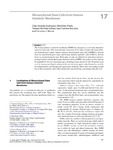Mesenchymal stem cells from human amniotic membrane

Not available until 9999-99-99
View/
Use this link to cite
http://hdl.handle.net/2183/36300Collections
- Investigación (FCS) [1293]
Metadata
Show full item recordTitle
Mesenchymal stem cells from human amniotic membraneAuthor(s)
Date
2014Citation
Sanjurjo-Rodríguez C, Díaz-Prado S, Hermida-Gómez T, Fuentes-Boquete I, Blanco FJ. Mesenchymal stem cells from human amniotic membrane. In: Atala A, Murphy SV, editors. Perinatal stem cells. New York: Springer; 2014. p. 191-198. Chapter 17.
Abstract
[Abstract] The human amnion or amniotic membrane (HAM) has emerged as a novel and alternative source of stem cells. This tissue presents a reservoir of two types of stem cells from different embryological origins: human amniotic mesenchymal stem cells (hAMSCs), derived from the mesodermal germ layer, and human amniotic epithelial cells (hAECs), derived from the ectodermal germ layer. Both types of cells are different in disposition and morphology but have similar phenotypic characterization. hAMSCs are easily to isolate and can be expanded in vitro for several passages, obtaining a large amount of cells. Properties such as to be immune-privileged, antimicrobial, and antitumorogenic make themselves suitable for transplantation, cell therapy, and regenerative medicine. These cells were widely studied due to these properties and to their pluripotent capacity, being a promising clinically tool.
Editor version
ISBN
978-1-4939-1117-2





